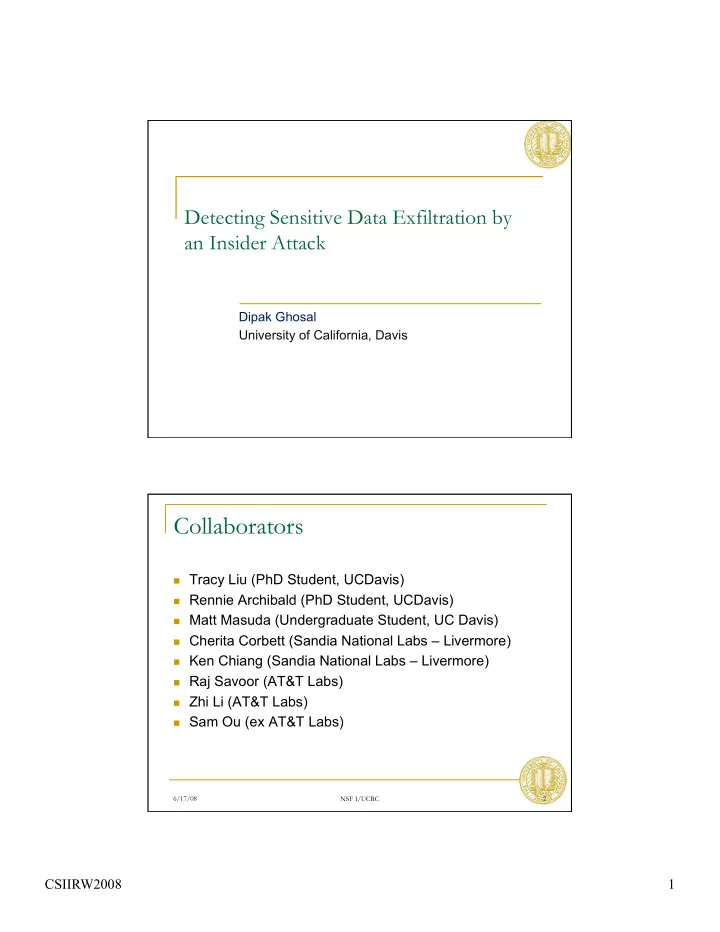

Detecting Sensitive Data Exfiltration by an Insider Attack Dipak Ghosal University of California, Davis Collaborators Tracy Liu (PhD Student, UCDavis) Rennie Archibald (PhD Student, UCDavis) Matt Masuda (Undergraduate Student, UC Davis) Cherita Corbett (Sandia National Labs – Livermore) Ken Chiang (Sandia National Labs – Livermore) Raj Savoor (AT&T Labs) Zhi Li (AT&T Labs) Sam Ou (ex AT&T Labs) 6/17/08 NSF I/UCRC 2 CSIIRW2008 1
Outline Application Identification Content Signature Generation and Detection Detecting Covert Communication Research Directions NSF I/UCRC 6/17/08 3 Insider Attack and Insider Threat Insider attack “ The potential damage to the interests of an organization by a person who is regarded, falsely, as loyally working for or on behalf of the organization, or who inadvertently commits security breaches .” An insider attack can occur through Inadvertent security breach by an authorized user A planned security breach by an authorized user A compromised system by an outsider 6/17/08 NSF I/UCRC 4 CSIIRW2008 2
Sensitive Information Dissemination Detection (SIDD) System 6/17/08 NSF I/UCRC 5 Application Tunneling Current research has addressed the issue of identifying the application layer protocols SSH, HTTP, FTP, etc. More fine grained identification is required for variety of applications that run over HTTP. Social networking (MySpace and Facebook) Web-mail (Gmail and Hotmail) Streaming video applications (Youtube and Veoh) 6/17/08 NSF I/UCRC 6 CSIIRW2008 3
Signals Inter-arrival time : derived from the sequence of timestamps noted by the sniffer for packets inbound to the host Inter-departure time : derived from the sequence of timestamps noted by the sniffer for packets outbound from the host Incoming packet size : vector of packet sizes for HTTP packets inbound to the host Outgoing packet size : vector of packet sizes for packets outbound from the host Outgoing Discrete Time Total Bytes : vector of outgoing bytes of data aggregated over discrete and fixed time bins 6/17/08 NSF I/UCRC 7 Signals – Examples Outgoing packet size vs. incoming packet size 6/17/08 NSF I/UCRC 8 CSIIRW2008 4
Experimental Setup 6/17/08 NSF I/UCRC 9 Temporal Statistics 6/17/08 NSF I/UCRC 10 CSIIRW2008 5
Temporal Characteristics 6/17/08 NSF I/UCRC 11 Wavelet Analysis Use Haar wavelet Feature used for comparison Variance of the Level-5 detailed co- efficients 6/17/08 NSF I/UCRC 12 CSIIRW2008 6
Content Identification: Motivation Can we detect illegal dissemination of protected digital (media) assets? 6/17/08 NSF I/UCRC 13 Content Signature Content-based Signature “The media itself is a watermark” Unique and robust Different content should have distinct signatures The signatures are tolerant to various forms of noise and distortions Requirements vary with applications From video search to detecting video copying 6/17/08 NSF I/UCRC 14 CSIIRW2008 7
Content Signature Generation Basic idea Extract a time series (or signal) of the content and analyze the signal to generate the signatures Capture the temporal correlation in the signature Treating the content signatures as time series Use signal processing techniques and tools to analyze Wavelet transform Any portion of the content can be used for detection Computation cost saving 6/17/08 NSF I/UCRC 15 Content Signature Generation – Example The Detailed Coefficients of the Star Wars Movie Signature Level (Scale) Signatures Translation 6/17/08 NSF I/UCRC 16 CSIIRW2008 8
Preliminary Analysis ROC curve in rate adaption case 2 ROC curve in rate adaption case 1 6/17/08 NSF I/UCRC 17 Detecting Covert Communication Exfiltration of sensitive information may be carried out using covert communication Hiding content/communication in an innocuous carrier using a steganography tool Challenges The content may be encrypted Different types of carriers 6/17/08 NSF I/UCRC 18 CSIIRW2008 9
Audio Steganalysis The analysis and classification method of determining if an audio bears hidden information Easy to establish Voice over Internet Protocol (VoIP) and other Peer-to-Peer (P2P) audio service High hidden capacity Inherent redundancy in the audio signal Its transient and unpredictable characteristics Human ear is insensitive to small distortions 6/17/08 NSF I/UCRC 19 Main Points A new approach to detect hidden content in audio files Uses Hausdorff distance and feature vectors based on higher-order statistics Good detection rate even with low hidden ratio 6/17/08 NSF I/UCRC 20 CSIIRW2008 10
Comparative Analysis 6/17/08 NSF I/UCRC 21 Research Directions Improving the techniques Wavelet analysis allows time frequency localization Where approximately time certain frequencies occur Is it useful in disambiguating applications? Co-integration can extract similarities in signals that may be uncorrelated Can this be used to detect content that is encrypted and/or modified to evade detection? Developing prototypes A VoIP steganalysis tool A classifier for network level application identification 6/17/08 NSF I/UCRC 22 CSIIRW2008 11
Recommend
More recommend